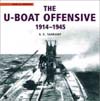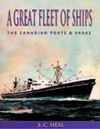The U-Boat Offensive 1914-1945
Tarrant, V.E.
2000, Cassell Academic
ISBN 185409520X
Hardcover, 192 pages, 114 pictures, 16 maps, 8 graphs
| Type. | General History |
| Pros. | Excellent summary of the U-boat campaign in both world wars |
| Cons. | Nothing major |
| Rating. |  |
 In the preface to The U-Boat Offensive 1914-1945, V.E. Tarrant notes that the purpose of his book is "to complement [Eberhard] Rössler's work [The U-Boat] by chronicling the strategic and tactical evolution of the U-boat through the two world wars, tracing how vessels originally conceived as coastal defence units evolved into a deadly menace and came close to being the single decisive factor in both wars." While not anywhere near as massive or comprehensive as Rössler's work on U-boat design, Tarrant succeeds in
presenting a clear overview of the U-boat campaign in both world wars which also provides the basis for further reading.
In the preface to The U-Boat Offensive 1914-1945, V.E. Tarrant notes that the purpose of his book is "to complement [Eberhard] Rössler's work [The U-Boat] by chronicling the strategic and tactical evolution of the U-boat through the two world wars, tracing how vessels originally conceived as coastal defence units evolved into a deadly menace and came close to being the single decisive factor in both wars." While not anywhere near as massive or comprehensive as Rössler's work on U-boat design, Tarrant succeeds in
presenting a clear overview of the U-boat campaign in both world wars which also provides the basis for further reading.
The U-Boat Offensive covers the campaigns chronologically with 18 short, unnumbered chapters, ranging from "A Weapon of Uncertain Value, August to December 1914" through such events as "The Sharp Edge of the Sword, Unleashing the Unrestricted Campaign, February to April 1917" and "Paukenschlag, The Fourth Phase, January to July 1942" and culminating in "Twilight and Defeat, the Seventh and Eighth Phases, October 1943 to May 1944 and June 1944 to May 1945." Each chapter includes a short description - the entire book is under 200 pages including 40 pages of appendixes and references - which covers the critical command decisions, key battles and operations, political developments, and Allied antisubmarine activities. Chapters close with a listing of U-boats lost during the period, including date, location, and cause, plus a running total of causes of destruction for the conflict. About half the book deals with U-boats during the First World War.
Tarrant draws upon the insights of earlier commentators including Marder and Hessler and official publications, while interspersing his own observations in a very clear writing style. There are few if any extraneous points - everything adds to a tightly constructed whole. While the author explicitly claims (and achieves) political non-partisanship and objectivity, the underlying structure and tone is that of an argument and not a summary. The U-boat's failure in both wars, he contends, was the result of qualitative and not quantitative factors. Germany's defeat in World War I, Tarrant shows, was the result of not having an answer to counter the introduction of convoys from the summer of 1917. Failure in World War II, meanwhile, can be traced not to a lack of boats (Germany would ultimately commission over 1,100 submarines with 830 seeing action), but rather that by the spring of 1943 all existing boats, with their limited underwater speed and endurance, had effectively been rendered obsolescent by improved Allied antisubmarine measures.
A decided strength of the book is its design and the inclusion of numerous graphs, maps, and pictures. All too many naval history books, even larger format hardbacks, use maps and graphs too sparingly and then as mere eye candy rather than as an integral part of the point they are advancing; this is clearly not the case with The U-Boat Offensive, where such material is a central part of the work. Rather than simply describing where U-boats operated at various times, for example, maps show the location of merchant ships sunk. The number of boats in service is shown graphically in many chapters, and is at times graphed directly against total tonnage sunk.
Extensive appendices include a listing for both wars of monthly additions and subtractions from the U-boat force, monthly totals of tonnage sunk by area, and U-boat specifications. Also included is a listing of merchant tonnage sunk by individual U-boat in World War I by year, a table showing the assignment of boats to the various flotillas from June 1940 through the end of the war, and the text of Wolfgang Lüth's famous lecture on "Problems of Leadership in a Submarine." This material provides a wealth of information for further analysis. The only danger with such material, including the information on U-boat losses, is that new archival research and underwater discoveries such as that of U-869 periodically improve our understanding of the past. Given that this book was first published over a decade ago, a small amount of its detailed information has become outdated, though this does not detract from the author's points.
Overall, The U-Boat Offensive serves as an excellent introduction to the U-boat campaign of both wars. For those unfamiliar with the broad outlines of the struggle under the sea, this book serves as a concise entry to the subject. For those with greater knowledge, the account remains highly readable while the appendices contain a treasure trove of otherwise difficult to obtain data.
Review written by Michael Lowrey.
Published on 30 Jun 2000.
This title is highly recommended.
Purchase information: (info) Get The U-Boat Offensive 1914-1945 now at amazon.co.uk
Get The U-Boat Offensive 1914-1945 now at amazon.co.uk
Return to our main review page.



